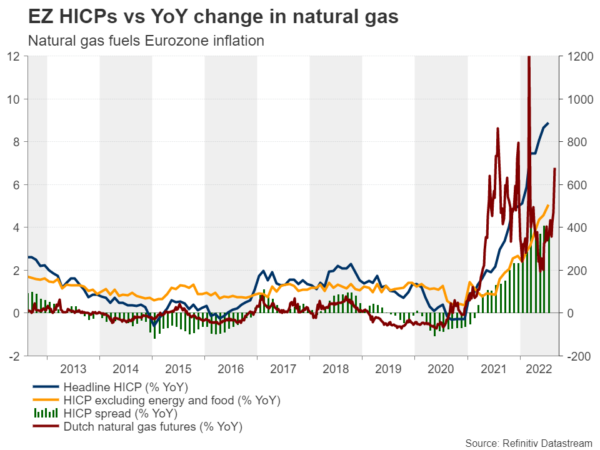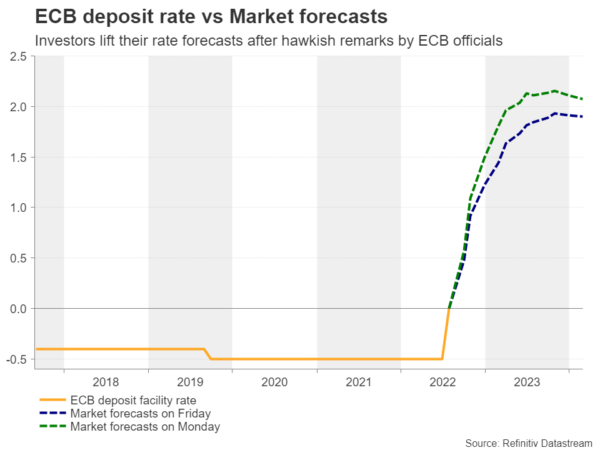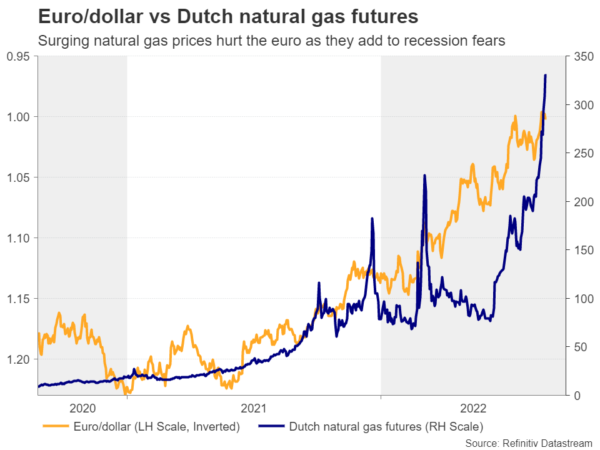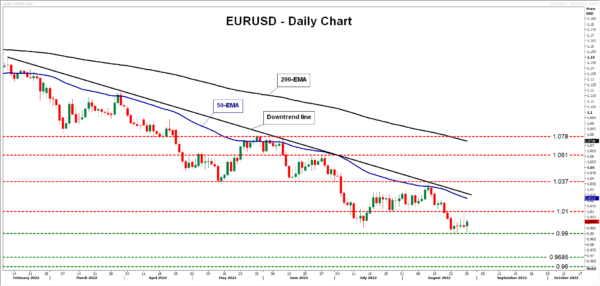With the August S&P flash composite purchasing managers index (PMI) signaling that the Euro area economy is on the verge of recession and the problem of energy supply in Europe getting worse day by day, euro traders have been reluctant to bring euro/dollar back above parity permanently. Now they may turn their gaze to Eurozone’s preliminary inflation numbers for August, due out on Wednesday at 09:00 GMT, as they try to figure out what the outcome will mean for the ECB’s future course of action, and subsequently, the common currency.
Headline inflation to hit a new record
After hitting a record high of 8.9% year-over-year in July, the headline harmonized index of consumer prices (HICP) is expected to have ticked higher to 9.0%, while the core rate, which excludes the volatile items of food and energy, is forecast to have held steady at 5.1% yoy. This suggests that high energy costs remain the primary inflator of consumer prices.
With oil prices correcting lower during the summer months, the spotlight has fallen to natural gas, with the Dutch futures hitting another record on Friday. Looking at the graph below, we see that, although very volatile recently, the yearly change in natural gas prices has been decently correlated with the spread between the headline and core inflation rates.
Following the sanctions imposed by the European Union on Russia for invading Ukraine, gas giant Gazprom has slashed gas flows to Germany – Eurozone’s economic powerhouse – via the Nord Steam 1 pipeline to only 20% of capacity. With the winter getting closer and Gazprom planning to close the pipeline for a three-day maintenance on Wednesday, euro traders are becoming increasingly nervous that the supply shortages and the increasing demand for heating gas will drive prices even higher and thereby drag the whole Euro-area economy into recession. That’s maybe why the euro has been suffering, even with the ECB appearing more hawkish than previously anticipated.
Investors place bets over a bigger September hike
In July, ECB policymakers raised interest rates twice as much as they had indicated after the June meeting, signaling that further increases are likely for the rest of the year. Lately, investors had been largely anticipating 50 more basis points to be served at the September gathering, but comments by a couple of ECB rate-setters over the weekend have prompted some investors to shift their bets to a 75bps hike. The level when a peak is expected was also raised, but the timing was kept untouched at October 2023.
And yet, the euro was not resurrected. In contrast to how the dollar reacts to the prospect of higher interest rates in the US, the common currency is hurt by such expectations. Maybe its traders are more concerned over the ECB dragging the Euro-area economy into recession, rather than trusting it to relieve them from the pain of very high consumer prices. That conclusion is also supported by the fact that the euro is inversely correlated, rather than directly, to natural gas prices. With the picture expected to only get darker, this means that the euro/dollar pair may be destined to drift further below parity.
Where is euro/dollar headed next?
Yes, higher inflation could initially result in some automatic euro buying, but any recovery could stay limited near the 1.010 zone, marked by the inside swing lows of July 26 and 27, or near the downtrend line drawn from the high of February 10. Sellers may shoot again from near those resistance zones, pushing the pair back down to the 0.9900 territory. A break lower would confirm a forthcoming lower low and could pave the way towards the 0.9685 or 0.9600 zones, defined as supports by the lows of October and September 2002, respectively.
For a near-term reversal to start being examined, a break above 1.0370 may be needed, accompanied by improving Eurozone economic data. Such a move may also confirm the break above the downtrend line and could see scope for advances towards the 1.0610 territory, the break of which may allow extensions towards the 1.0780 zone, which acted as a ceiling between May 27 and June 6.

















